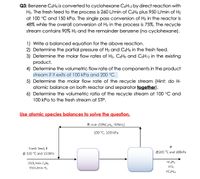
Introduction to Chemical Engineering Thermodynamics
8th Edition
ISBN: 9781259696527
Author: J.M. Smith Termodinamica en ingenieria quimica, Hendrick C Van Ness, Michael Abbott, Mark Swihart
Publisher: McGraw-Hill Education
expand_more
expand_more
format_list_bulleted
Question
first 2 most important

Transcribed Image Text:Q3: Benzene CaHs is converted to cyclohexane CsH12 by direct reaction with
H2. The fresh feed to the process is 260 L/min of CoHs plus 950 L/min of H2
at 100 °C and 150 kPa. The single pass conversion of H2 in the reactor is
48% while the overall conversion of Hz in the process is 75%. The recycle
stream contains 90% H2 and the remainder benzene (no cyclohexane).
1) Write a balanced equation for the above reaction.
2) Determine the partial pressure of H2 and CoHs in the fresh feed.
3) Determine the molar flow rates of H2. CsHo and C&H12 in the existing
product.
4) Determine the volumetric flow rate of the components in the product
stream if it exits at 100 kPa and 200 °C.
5) Determine the molar flow rate of the recycle stream (Hint: do H-
atomic balance on both reactor and separator together).
6) Determine the volumetric ratio of the recycle stream at 100 °C and
100 kPa to the fresh stream at STP.
Use atomic species balances to solve the question.
R male (10%CH, 90%H;)
100 °C, 100 kPa
Fresh feed, F
@ 200 °C and 100kPa
@ 100 °C and 150kPa
26OL/min CH,
950L/min H;
nH2
nC;H12
Expert Solution
This question has been solved!
Explore an expertly crafted, step-by-step solution for a thorough understanding of key concepts.
This is a popular solution
Trending nowThis is a popular solution!
Step by stepSolved in 2 steps

Knowledge Booster
Similar questions
- Derivation of the general equation for interpolation: develop from scratch the equation interpolation you need to developarrow_forwardWhat types of the boundary conditions we have?arrow_forwardGive a table showing classification of mass transfer operations used in Chemical industries with phases of contactarrow_forward
- For which set of crystallographic planes will a first-order diffraction peak occur at a diffraction angle of 44.53° for FCC nickel (Ni) when monochromatic radiation having a wavelength of 0.1542 nm is used? The atomic radius for Ni is 0.1246 nm. 1) ( eTextbook and Media Assistance Usedarrow_forwardHelp mearrow_forwardQ4/ Reduce the following system by using Masson's method: G7 H8 G5 G6 G4 G₁ G2 G3 H4 H5 H6 H₁ H₂ H3 G8 H7arrow_forward
- Give a brief description of the use of hydrostatic pressure in level measurement. List the main advantages and disadvantages. What is the formula used to deduce level from pressure?arrow_forwardXi = уір ресто drive to get this equation lap = when УА + Ув YA Ус PA(T) PALT) PACT)arrow_forwardwhat is the number of electrons that an ion of iodine would most commonly have?arrow_forward
arrow_back_ios
arrow_forward_ios
Recommended textbooks for you
 Introduction to Chemical Engineering Thermodynami...Chemical EngineeringISBN:9781259696527Author:J.M. Smith Termodinamica en ingenieria quimica, Hendrick C Van Ness, Michael Abbott, Mark SwihartPublisher:McGraw-Hill Education
Introduction to Chemical Engineering Thermodynami...Chemical EngineeringISBN:9781259696527Author:J.M. Smith Termodinamica en ingenieria quimica, Hendrick C Van Ness, Michael Abbott, Mark SwihartPublisher:McGraw-Hill Education Elementary Principles of Chemical Processes, Bind...Chemical EngineeringISBN:9781118431221Author:Richard M. Felder, Ronald W. Rousseau, Lisa G. BullardPublisher:WILEY
Elementary Principles of Chemical Processes, Bind...Chemical EngineeringISBN:9781118431221Author:Richard M. Felder, Ronald W. Rousseau, Lisa G. BullardPublisher:WILEY Elements of Chemical Reaction Engineering (5th Ed...Chemical EngineeringISBN:9780133887518Author:H. Scott FoglerPublisher:Prentice Hall
Elements of Chemical Reaction Engineering (5th Ed...Chemical EngineeringISBN:9780133887518Author:H. Scott FoglerPublisher:Prentice Hall
 Industrial Plastics: Theory and ApplicationsChemical EngineeringISBN:9781285061238Author:Lokensgard, ErikPublisher:Delmar Cengage Learning
Industrial Plastics: Theory and ApplicationsChemical EngineeringISBN:9781285061238Author:Lokensgard, ErikPublisher:Delmar Cengage Learning Unit Operations of Chemical EngineeringChemical EngineeringISBN:9780072848236Author:Warren McCabe, Julian C. Smith, Peter HarriottPublisher:McGraw-Hill Companies, The
Unit Operations of Chemical EngineeringChemical EngineeringISBN:9780072848236Author:Warren McCabe, Julian C. Smith, Peter HarriottPublisher:McGraw-Hill Companies, The

Introduction to Chemical Engineering Thermodynami...
Chemical Engineering
ISBN:9781259696527
Author:J.M. Smith Termodinamica en ingenieria quimica, Hendrick C Van Ness, Michael Abbott, Mark Swihart
Publisher:McGraw-Hill Education

Elementary Principles of Chemical Processes, Bind...
Chemical Engineering
ISBN:9781118431221
Author:Richard M. Felder, Ronald W. Rousseau, Lisa G. Bullard
Publisher:WILEY

Elements of Chemical Reaction Engineering (5th Ed...
Chemical Engineering
ISBN:9780133887518
Author:H. Scott Fogler
Publisher:Prentice Hall


Industrial Plastics: Theory and Applications
Chemical Engineering
ISBN:9781285061238
Author:Lokensgard, Erik
Publisher:Delmar Cengage Learning

Unit Operations of Chemical Engineering
Chemical Engineering
ISBN:9780072848236
Author:Warren McCabe, Julian C. Smith, Peter Harriott
Publisher:McGraw-Hill Companies, The